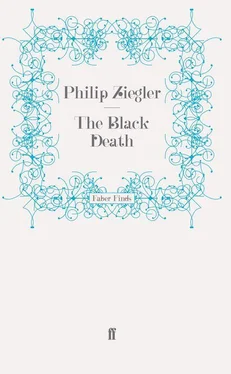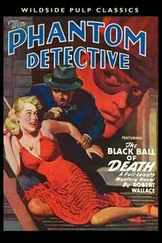Flagellation as a practice seems to be almost as old as man himself. Joseph McCabe has pursued the subject with loving detail through the ages: {165} 165 14 J. McCabe, The History of Flagellation, Girard, Kansas, 1946.
from the Indians of Brazil who whipped themselves on their genitals at the time of the new moon through the Spartans who propitiated the fertility goddess with blood until finally he arrived at the thirteenth and fourteenth century – the ‘Golden Age of Pious Flagellation’. Most of these exercises were clearly if unconsciously erotic in their nature. As such, they were far removed from the pilgrimages of the Brethren of the Cross. It would be rash to assert that the Flagellants of 1348 did not satisfy, by their self-inflicted torments, some twisted craving in their natures, but ‘erotic’, in its normal sense of awakening sexual appetites, is not a word which can properly be applied to their activities.
The practice of self-scourging as a means of mortifying the flesh seems to be first recorded in Europe in certain Italian monastic communities early in the eleventh century. As a group activity it was not known for another two hundred years. At this point, in the middle of the thirteenth century, a series of disasters convinced the Italians that God’s anger had been called down on man as a punishment for his sins. The idea that he might be placated if a group of the godly drew together to protest their penitence and prove it by their deeds seems first to have occurred to a Perugian hermit called Raniero. The project was evidently judged successful, at any rate sufficiently so for the experiment to be repeated in 1334 and again a few years later, when the pilgrimage was led by ‘a virtuous and beautiful maid’. This last enterprise ran foul of the authorities and the maid was arrested and sentenced to be burnt at the stake. Either her virtue or her beauty, however, so far melted the hearts of her captors that she was reprieved and ultimately released.
The pilgrimage of 1260 drew its authority from a Heavenly Letter brought to earth by an angel which stated that God, incensed by man’s failure to observe the Sabbath day, had scourged Christendom and would have destroyed the world altogether but for the intercession of the angels and the Virgin and the altogether becoming behaviour of the Flagellants. Divine grace would be forthcoming for all those who became members of the Brotherhood: anybody else, it was clear, was in imminent danger of hellfire. A second edition of this letter was issued in time for the Black Death by an angel who was said to have delivered it in the Church of St Peter in Jerusalem some time in 1343. {166} 166 15 Lea, History of the Inquisition, Vol. II, pp. 382–3.
The text was identical with the first except for an extra paragraph specifically pointing out that the plague was the direct punishment of God and that the aim of the Flagellants was to induce God to relent.
The ‘Brotherhood of the Flagellants’ or ‘Brethren of the Cross’ as the movement was called in 1348, traditionally originated in Eastern Europe, headed, according to Nohl in a pleasant conceit for which he unfortunately fails to quote authority, by various ‘gigantic women from Hungary’. {167} 167 16 J. Nohl, Schwarze Tod, op. cit., p. 303.
It is to be deplored that these heroic figures quickly faded from the scene. It was in Germany that the Flagellant movement really took root. It is hard to be sure whether this was the result of circumstances or of the nature of the inhabitants. Dr Lea suggests that the German people had had their religious sensibilities stirred by the papal interdict against Louis of Bavaria and the recent earthquakes. But, if such were the causes, there would have been quite as much reason to expect the outbreak in Italy, the original home of collective scourgings, deprived as it was of its Pope and in a mood of striking melancholia.
The actual mechanism of recruitment to the Brotherhood is still obscure but the appearance of the Flagellants on the march is well attested. {168} 168 17 See, in particular, Matthew of Neueburg (Matthiae Neuewen-burgensis), Fontes Rerum Germanicarum, ed. Boehmer, Stuttgart, Vol. IV, 1868, pp. 266–7.
They moved in a long crocodile, two-by-two, usually in groups of two or three hundred but occasionally even more than a thousand strong. Men and women were segregated, the women taking their place towards the rear of the procession. At the head marched the group Master and two lieutenants carrying banners of purple velvet and cloth of gold. Except for occasional hymns the marchers were silent, their heads and faces hidden in cowls, their eyes fixed on the ground. They were dressed in sombre clothes with red crosses on back, front and cap.
Word would travel ahead and, at the news that the Brethren of the Cross were on the way, the bells of the churches would be set ringing and the townsfolk pour out to welcome them. The first move was to the church where they would chant their special litany. A few parish priests used to join in and try to share the limelight with the invaders, but most of them discreetly lay low until the Flagellants were on the move again. Only a handful were so high-principled or foolhardy as to deny the use of their church for the ceremony and these were usually given short shrift by the Brethren and by their own parishioners.
Sometimes the Flagellants would use the church for their own rites as well as for the litany but, provided there was a market place or other suitable site, they preferred to conduct their service in the open air. Here the real business of the day took place. A large circle was formed and the worshippers stripped to the waist, retaining only a linen cloth or skirt which stretched as far as their ankles. Their outer garments were piled up inside the circle and the sick of the village would congregate there in the hope of acquiring a little vicarious merit. On one occasion, at least, a dead child was laid within the magic circle – presumably in the hope of regeneration. The Flagellants marched around the circle; then, at a signal from the Master, threw themselves to the ground. The usual posture was that of one crucified but those with especial sins on their conscience adopted appropriate attitudes: an adulterer with his face to the ground, a perjurer on one side holding up three fingers. The Master moved among the recumbent bodies, thrashing those who had committed such crimes or who had offended in some way against the discipline of the Brotherhood.
Then came the collective flagellation. Each Brother carried a heavy scourge with three or four leather thongs, the thongs tipped with metal studs. With these they began rhythmically to beat their backs and breasts. Three of the Brethren acting as cheer-leaders, led the ceremonies from the centre of the circle while the Master walked among his flock, urging them to pray to God to have mercy on all sinners. Meanwhile the worshippers kept up the tempo and their spirits by chanting the Hymn of the Flagellants. The pace grew. The Brethren threw themselves to the ground, then rose again to continue the punishment; threw themselves to the ground a second time and rose for a final orgy of self-scourging. Each man tried to outdo his neighbour in pious suffering, literally whipping himself into a frenzy in which pain had no reality. Around them the townsfolk quaked, sobbed and groaned in sympathy, encouraging the Brethren to still greater excesses.
Such scenes were repeated twice by day and once by night with a benefit performance when one of the Brethren died. If the details of the ceremonies are literally as recorded then such extra shows must have been far from exceptional. The public wanted blood and they seem to have got it. Henry of Herford {169} 169 18 Henry of Herford, Liber de rebus memorabioribus, ed. Potthast, Göttingen, 1859, p. 281.
records: ‘Each scourge was a kind of stick from which three tails with large knots hung down. Through the knots were thrust iron spikes as sharp as needles which projected about the length of a grain of wheat or sometimes a little more. With such scourges they lashed themselves on their naked bodies so that they became swollen and blue, the blood ran down to the ground and bespattered the walls of the churches in which they scourged themselves. Occasionally they drove the spikes so deep into the flesh that they could only be pulled out by a second wrench.’
Читать дальше












